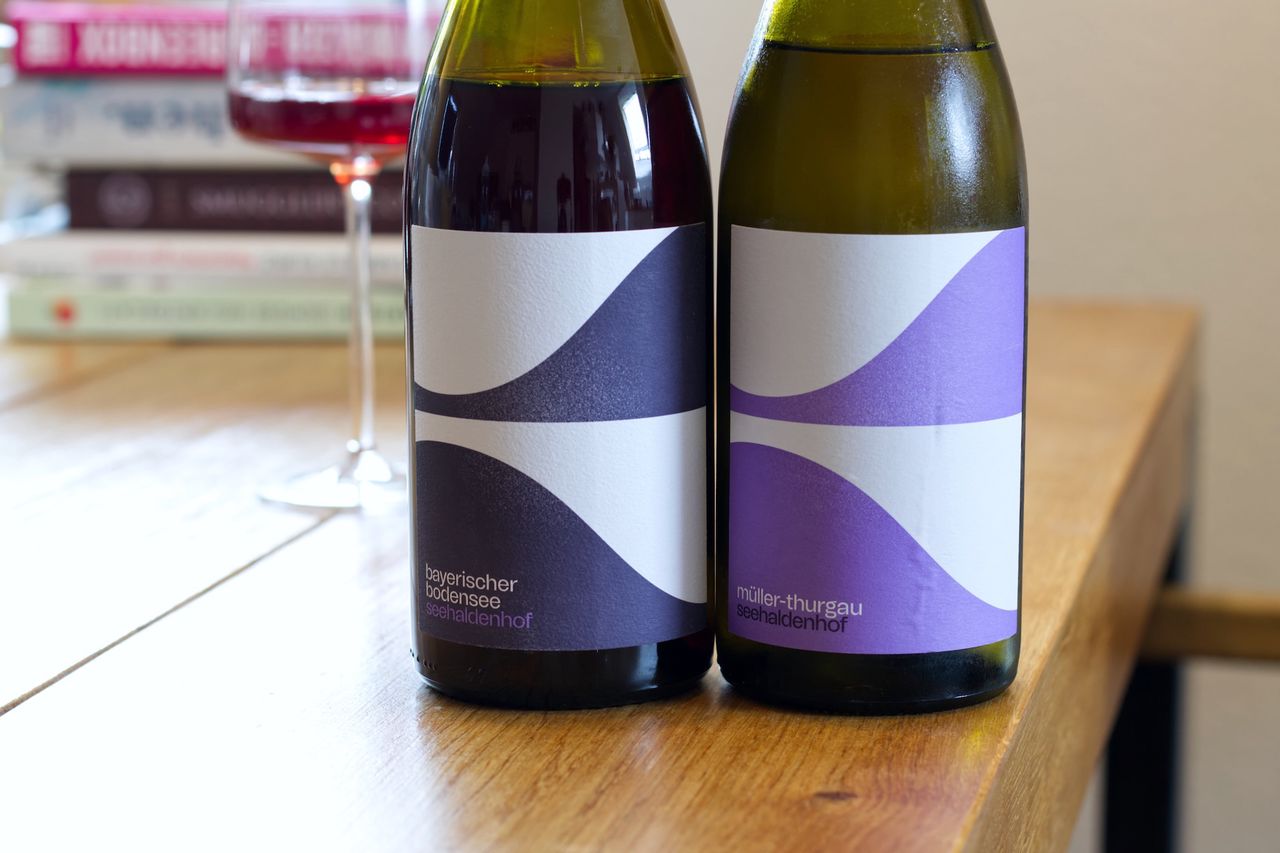Two Bottles Seehaldenhof
We are drinking two bottles from Seehaldenhof at the Bavarian Lake Constance: a Müller-Thurgau and a Spätburgunder from 2023.

A bit over two weeks ago, the third Stuttgart Landweintreff opened its doors in the former state parliament of the state capital. We tasted a lot and didn’t write down much. In fact, nothing at all, to be exact. But in exchange, we now own a second cloth bag with a happy local wine glass on it and that’s worth something too. The line-up was relatively similar to the second edition last year, peppered with the usual suspects when it comes to Landwein and other minimally intervened grape juice, as well as one or two new discoveries. Seehaldenhof belongs in the first category and was already present in 2024. Lately, wines from and around Nonnenhorn, not just those from Seehaldenhof, are popping up more and more here and there. Maybe sometimes still under the old estate name, Hornstein am See, which has been replaced by Seehaldenhof since early 2024. Lake Constance is slowly turning into a trendy wine hotspot. It occurs to me that it’s been over three years since Lanz (also at Landweintreff, also still great) was last drunk here. Time flies.
Incidentally, both bottles today made it through the quality wine inspection, which means that neither the Müller-Thurgau nor the Spätburgunder are labeled as Landwein. But what is on the label is Württemberg. At least on the back. The front says Bavarian Lake Constance, which, although located in the state of Bavaria, wine-legally belongs to Württemberg, but as an indication of origin definitely makes more sense, since place and climate have very little to do with what you usually drink as Württemberg. Only about 90 hectares belong to this area on the northeastern shore of Lake Constance near Lindau, Wasserburg, Bodolz, and Nonnenhorn. Both wines are regional wines and therefore the entry-level at Seehaldenhof. The grapes grow near the lake on soils left behind by glaciers in one of the last ice ages. The Müller is pressed, spontaneously fermented, and then matured on the lees for half a year in a mix of stainless steel, large wood, and small wood before being bottled. The Spätburgunder is also spontaneously fermented and then matured for about one and a half years in small wooden barrels, with only a few new barrels used.
As usual, we start with the white wine. It’s a little yeasty, floral, and has a colorful mix of herbs on the nose. You look for fruit in this herbal-floral mixture in vain at first, but that’s fine. It smells somehow grippy, seems cool, lean, and focused, and that’s exactly what the first sip tastes like. Cool, focused, crystal clear, and again far from fruit. At most, the acidity, which is reminiscent of green apples, including the texture of the fruit flesh. Tasty, really brutally tasty, and unexpectedly persistent. Strong.
Even on the second evening, it remains mainly a yeasty-herbal structured wine, which now has a touch of herbs exchanged for melon. The acidity is present, but rather in the background. It’s a bit creamier now, but at least as long and clear as on the first evening. And now the green apple is more melon in aroma too. Still beautiful. Müller-Thurgau has its incredibly lousy reputation for a reason. And even I have to rack my brain to remember when I last poured myself a Müller at the dinner table here. In vain. The last single-varietal on the blog is also three years ago. But if you set that aside for a moment and just ignore it, you have to try this wine. Your own horizons will thank you.
Unlike the Müller, the Spätburgunder has plenty of fruit. Cherry, lots of red, already slightly mushy berries, and then the spice behind that. And even further back is an old leather sofa. When drinking, the cherry is more artificial than real and anyone who slurps (like us) is caught up by the spice, which on the tongue is then replaced again by cherry. It’s somehow uncomplicated without being simple, has drive, is just as clear as the Müller, just as straightforward and at least as tasty. Lucky is the one who can start their range this way and it’s easy to see why these wines are popping up more and more on the radar.
Where the Müller-Thurgau discovers fruit overnight, the opposite happens with the Pinot. Not that cherry and berries disappear. But they step back. Now there’s sandalwood, damp earth, and a bit of dark chocolate. The wine feels a touch warmer to drink, tastes like forest berry cake on a chocolate base, sweet cherries, and dark spice. It’s just really good. Sure, the great wines are greater. But that’s ideally not a particularly hot take, because if the winery knows what it’s doing, hopefully, more is always more. And here, they know what they’re doing, and the village and single-vineyard wines add a solid notch on top. But how high the entry level is here at the bottom. That is truly remarkable.